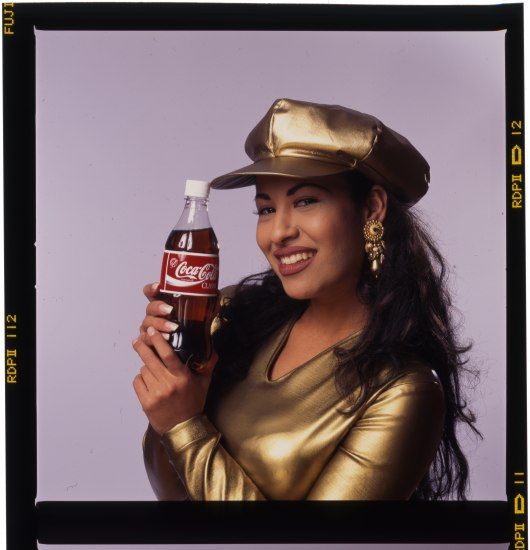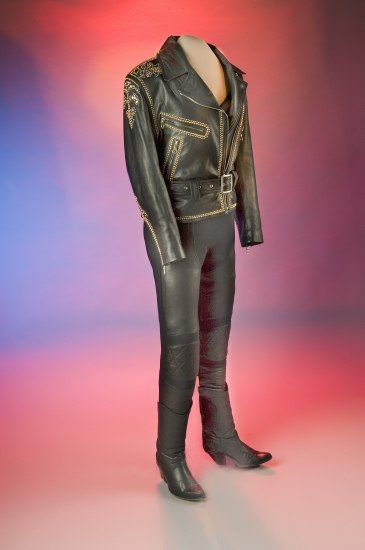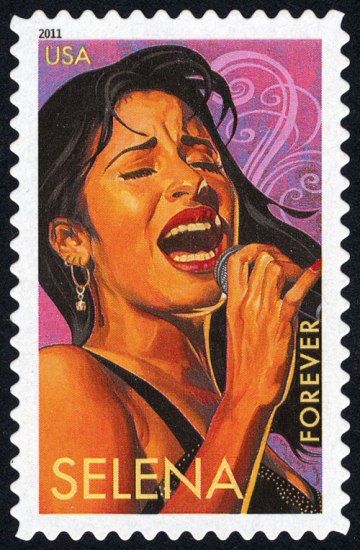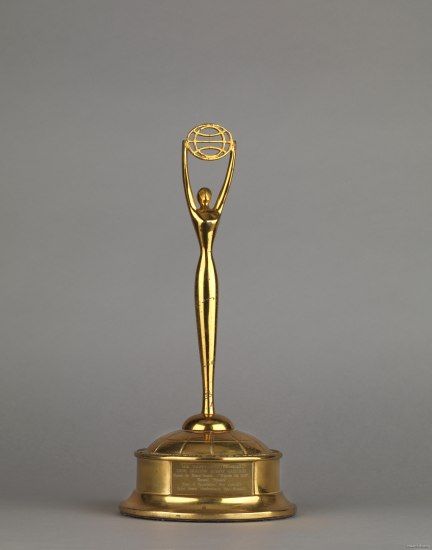NATIONAL MUSEUM OF AMERICAN HISTORY
How Do We Remember Selena?
Three women on the National Museum of American History staff share their personal connections with Selena and discuss why her legacy matters not just to them but to many Americans.

From the 1950s to 1970s, U.S. advertising started to shift from mass marketing to recognizing and defining distinct target markets. A unique example of this includes the rise of Selena Quintanilla-Pérez (1971–1995), whose hard-won fame spoke to a large cross-section of fans in the United States, in Latin American markets, and across the world. A display opened in 2017 in the American Enterprise exhibition explores marketing history and this pop icon.
Three women on the National Museum of American History staff share their personal connections with Selena and discuss why her legacy matters not just to them but to many Americans.
When Selena was...
On the evening of March 31, 1995, we returned home to the blinking light of the answering machine. Each message from Cousin Victor in San Antonio, Texas, was more frantic than the last. "Berin and Melinda, call home immediately." All we understood was that someone had been shot.
That someone turned out to be Selena Quintanilla-Perez—the 23-year-old Tejana singer who had just become the first Latina artist to top the U.S. Billboard 200 chart with her predominantly Spanish-language album. And somehow we had missed the news that Friday morning. The World Wide Web was relatively new. There were no smart phones. So it wasn't until that night that we learned she had been killed by the woman who was managing the Selena fan club and the artist's boutiques.
As I prepare to publicize the museum's Hispanic Advertising History initiative with the opening of a new display on that includes Selena artifacts, I can look back and see how my life intersected with hers and how I came to know and admire who she was. It's a good opportunity to reflect on the impact she made on American culture and to mourn what could have been.
At a time when she was popular across the Southwest and in Mexico but relatively little known in other parts of the U.S., we saw Selena perform in Washington, D.C., in 1993. That year's Hispanic Heritage Month provided a forum for members of Congress and Hispanic arts organizations to showcase the amazing talent in their respective districts. My memory is a little fuzzy as to the event we attended but it was most likely the Congressional Hispanic Caucus Institute Gala as Representative Solomon Ortiz of Texas, whose district included Corpus Christi where Selena grew up, was the chairman responsible for the program. But my memory is clear about the energetic performance Selena gave. In her signature leather jacket with bejeweled bra underneath, her mane of hair flew as she crossed the stage to the rousing rhythm of the large band behind her, sending out the sounds of South Texas, familiar to us from weddings, quinceañeras, and bailes, or dances, out into the nation's capital.

In late September 1998, my husband joined me on a work trip to New Orleans that ended up with us trapped in the city ahead of Hurricane Georges—flights were canceled and the city shut down. But we were lucky—our hotel was one of the few with its own generator and so we had power and cable TV. The Selena biographical film, starring Jennifer Lopez, had never opened in D.C. so we had not seen the 1997 movie. We were soon immersed in the story of an American family, a family much like the ones we grew up in. And it is this movie that has ensured her legacy is passed down from generation to generation.
Selena's family donated one of her performance costumes to the museum in 1999, shortly after I arrived as the director of public affairs. This outfit, with its leather boots, spandex pants, satin bustier, and motorcycle jacket, was iconic of what our then curator of Latino history and culture Marvette Pérez described as Selena's idiosyncratic style, "wavering between sexy rebel and Mexican American good girl." We placed the costume on view in 2001 as part of Moda y Música: Stage, Fashion, and Style, a display of four showcases featuring Hispanic performers and designers. Raised speaking English, Selena had to learn to sing Spanish phonetically. Ironically, her "cross-over" material for English-language radio was not released until the end of her career.
When "Despacito" reached the number one spot on Billboard's Hot 100 chart, I could only wonder, what if she had lived? Would Selena have been first?
Melinda Machado is the museum's Director of Communications and Marketing and is a Texan of Mexican American and Cuban descent.
Who Selena was…
If you were a teenage Latina in Texas in the mid-1990s, chances are you not only knew who Selena was, you were also a fan. Despite the fact that both my parents listened to her music and both attended what became her final concert at the Houston Rodeo, I was an exception. As a kid, my dad introduced me to his Beatles albums and big band music. At 16, I was more interested in the Fab Four and Frank Sinatra than I was the young woman whose looks were more reminiscent of my own.
Still, I have vivid memories of March 31, 1995, and seeing the tears in the eyes of family friends when news broke that Selena had been shot. I remember spending the afternoon on that last day of my spring break watching the story unfold. I also remember trying to understand what was so special about this person I knew so little about.

Two years later when a movie about her life was released I went with some friends to see what I could learn about the Tejano music superstar whose death had catapulted her to legendary status. This is what I found out: Selena Quintanilla grew up in southeast Texas, as did I. She was Mexican American, as was I. She loved disco and rock music, so did I.
What surprised me the most was finding out Spanish was not Selena's first language. My parents, grandparents, and relatives spoke Spanish but my generation of the family had not been taught it. We were never bothered by this. In fact, it never occurred to me to care until I was old enough to face other people's judgement and assumptions. The more I looked into the life of Selena, the more I realized that this young woman who had become a Latina icon faced similar adversity by not being as "culturally appropriate" as some thought she should be.
Selena's story is as American as one could get. She had hopes and dreams just like the rest of us. She had a family that supported those dreams and did what they could to make them a reality. She may have achieved success as a recording artist but she never intended to limit herself. She was determined to enter the fashion industry and had begun to step into the realm of celebrity endorsements. Though she had been performing for the majority of her life, her career was only just getting started.
In life, and in death, Selena meant many things to many people. Her significance to Tejano music and the efforts for her to "cross-over" to English music are not lost on anyone, but it is her impact as a businessperson that we are now able to get a sense of as we look back. If her life had not been cut tragically short, there is no telling what she could have accomplished, but her ongoing popularity is a testament to her significance in American culture.
Amelia Thompson was a museum communications specialist and a native of Houston of Mexican American descent.
What Selena means…
Selena means car rides with my mother and singing as loud as I could in our little green minivan. To me, Selena represents all the rough days that could be solved by popping in a wonderful mix of songs and spending time with my family. The CD of my mother's own creation was always in the car. It featured Latina artists from Celia Cruz to Selena. Though Selena was murdered in 1995, a year before I was born, she was and still is very relevant to young Latinos everywhere. To me, her legacy lives on.
Selena succeeded in popularizing a genre of music that wasn't often in the limelight and got her album Dreaming of You, which was predominantly in Spanish, to the number-one slot on the Billboard 200 charts when it was released after her death. Her vivacity was infectious and she was a beacon of creativity and happiness. Her example is one of hope and determination to be the very best you can be and all it takes is passion, hard work, and surrounding yourself with people who love and care about you.
Listening to this music with my mom not only gave me an appreciation for the humility, talent, and passion of Selena. It also helped me to learn the language at a young age and made me curious about Spanish-language music as a whole. Artists like Selena popularized a different type of genre that the American public in many places wasn't always accustomed to. Released after her death, the movie Selenaintroduced more people to the young singer from Corpus Christi. Incidentally, it also served as a breakout for Jennifer Lopez, now an international music, movie, and television star.
In 2016, MAC Cosmetics issued a limited edition makeup line honoring Selena's legacy. The company created the line in response to a fan-generated petition asking for the creation of this collection. In October, women and men were interviewed in the lines waiting for store openings. It quickly sold out and it was relaunched just after Christmas, December 28 and 29—and sold out again. Despite the passage of time, Selena still has a huge impact on her original fans and on new generations of fans like me.

In the American Enterprise exhibition, the objects that will highlight Selena's contributions to Hispanic advertising history include her leather motorcycle jacket and beaded bra, photographs from the Coca-Cola advertising campaign, and Selena memorabilia that help to illustrate her personality, style, impact, and powerful fandom. The exhibit will give the public a chance to see pieces of who she was and the gorgeous music that she created. The display will also showcase the 1988 Clio Award that Sosa, Bromley, Aguilar & Associates, the advertising firm that worked with Selena in Texas, was awarded for work in HIV/AIDS awareness.

Having these objects on display in the museum gives me a sense of happiness and pride because of her music's influence on my life and the fact that she is being recognized for her contributions to America at the Smithsonian.
Even 22 years after her tragic death, her legacy is clear and many still love her music, music that has been passed down from parent to child as it was for me. While there is an outpouring of support toward representation of minorities in the country, there still aren't many who are as influential as Selena was in her day. She brought together many communities and people through the beauty of her music. Selena was one of my first introductions to the world of Latino artists and I wouldn't have it any other way.
Chloe Reynolds is a native of Virginia and a graduate of Bucknell University. She was a communications intern during the summer of 2017.
Learn more about Hispanic advertising and Selena's role in it in the museum's American Enterprise online exhibition.
You can learn more about Selena in this video, "Selena: Crossing Over Cultural Boundaries | Verónica A. Mendez and Mireya Loza," part of the Latinas Talk Latinas video series. A collaboration between the National Museum of American History and the Smithsonian Latino Center, the series explores the stories of 10 Latinas as told by curators, scientists, and educators across the Smithsonian.


